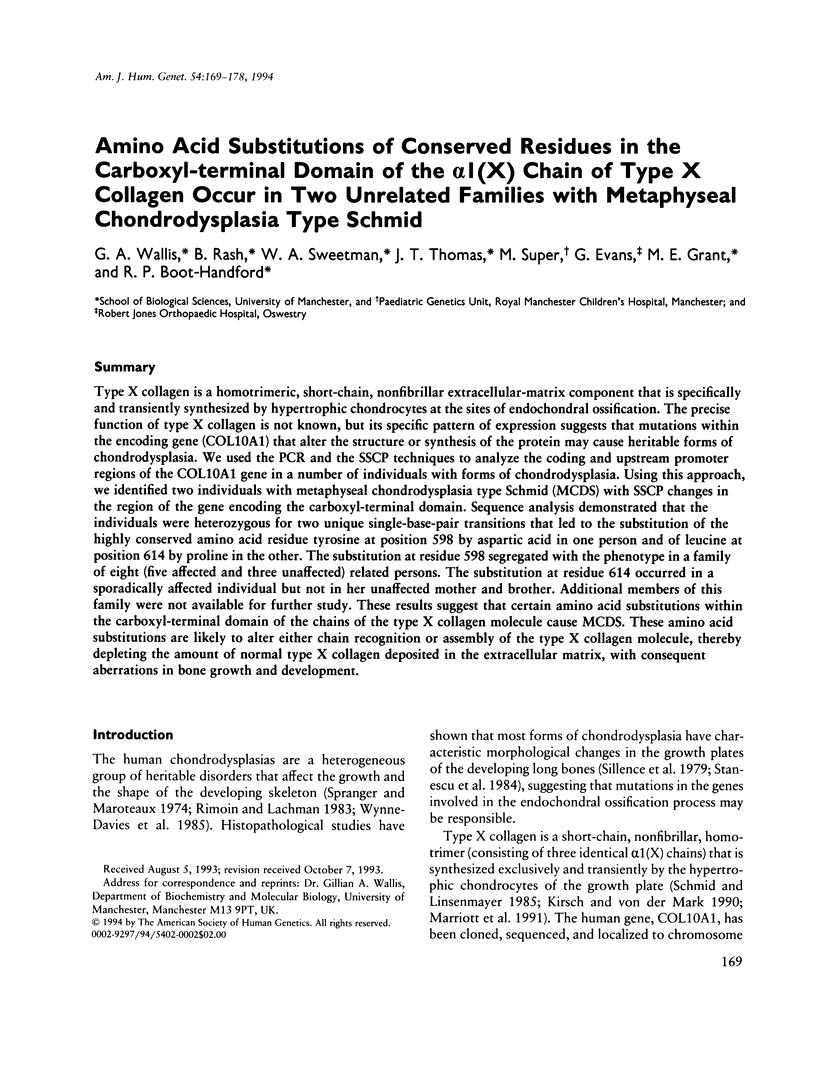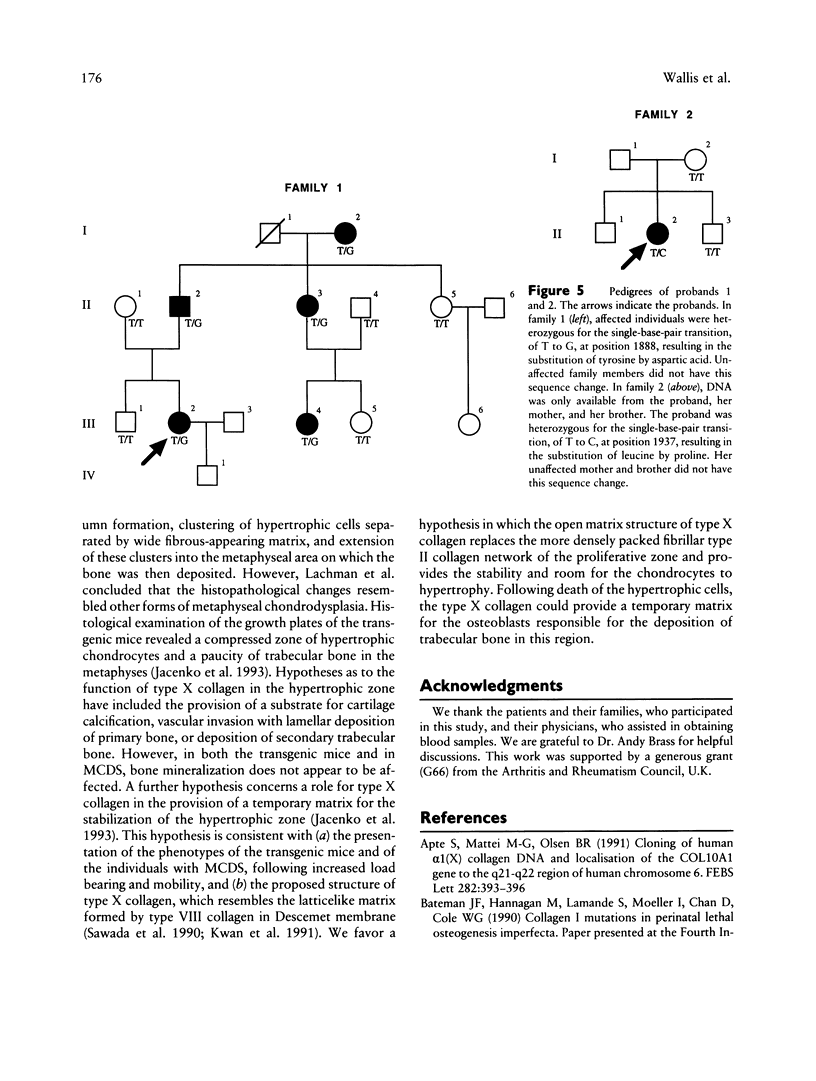Abstract
Type X collagen is a homotrimeric, short-chain, nonfibrillar extracellular-matrix component that is specifically and transiently synthesized by hypertrophic chondrocytes at the sites of endochondral ossification. The precise function of type X collagen is not known, but its specific pattern of expression suggests that mutations within the encoding gene (COL10A1) that alter the structure or synthesis of the protein may cause heritable forms of chondrodysplasia. We used the PCR and the SSCP techniques to analyze the coding and upstream promoter regions of the COL10A1 gene in a number of individuals with forms of chondrodysplasia. Using this approach, we identified two individuals with metaphyseal chondrodysplasia type Schmid (MCDS) with SSCP changes in the region of the gene encoding the carboxyl-terminal domain. Sequence analysis demonstrated that the individuals were heterozygous for two unique single-base-pair transitions that led to the substitution of the highly conserved amino acid residue tyrosine at position 598 by aspartic acid in one person and of leucine at position 614 by proline in the other. The substitution at residue 598 segregated with the phenotype in a family of eight (five affected and three unaffected) related persons. The substitution at residue 614 occurred in a sporadically affected individual but not in her unaffected mother and brother. Additional members of this family were not available for further study. These results suggest that certain amino acid substitutions within the carboxyl-terminal domain of the chains of the type X collagen molecule cause MCDS. These amino acid substitutions are likely to alter either chain recognition or assembly of the type X collagen molecule, thereby depleting the amount of normal type X collagen deposited in the extracellular matrix, with consequent aberrations in bone growth and development.
Full text
PDF









Images in this article
Selected References
These references are in PubMed. This may not be the complete list of references from this article.
- Apte S., Mattei M. G., Olsen B. R. Cloning of human alpha 1(X) collagen DNA and localization of the COL10A1 gene to the q21-q22 region of human chromosome 6. FEBS Lett. 1991 May 6;282(2):393–396. doi: 10.1016/0014-5793(91)80521-4. [DOI] [PubMed] [Google Scholar]
- Bateman J. F., Lamande S. R., Dahl H. H., Chan D., Mascara T., Cole W. G. A frameshift mutation results in a truncated nonfunctional carboxyl-terminal pro alpha 1(I) propeptide of type I collagen in osteogenesis imperfecta. J Biol Chem. 1989 Jul 5;264(19):10960–10964. [PubMed] [Google Scholar]
- Bonadio J., Byers P. H. Subtle structural alterations in the chains of type I procollagen produce osteogenesis imperfecta type II. Nature. 1985 Jul 25;316(6026):363–366. doi: 10.1038/316363a0. [DOI] [PubMed] [Google Scholar]
- Brass A., Kadler K. E., Thomas J. T., Grant M. E., Boot-Handford R. P. The fibrillar collagens, collagen VIII, collagen X and the C1q complement proteins share a similar domain in their C-terminal non-collagenous regions. FEBS Lett. 1992 Jun 1;303(2-3):126–128. doi: 10.1016/0014-5793(92)80503-9. [DOI] [PubMed] [Google Scholar]
- Byers P. H., Wallis G. A., Willing M. C. Osteogenesis imperfecta: translation of mutation to phenotype. J Med Genet. 1991 Jul;28(7):433–442. doi: 10.1136/jmg.28.7.433. [DOI] [PMC free article] [PubMed] [Google Scholar]
- Chessler S. D., Wallis G. A., Byers P. H. Mutations in the carboxyl-terminal propeptide of the pro alpha 1(I) chain of type I collagen result in defective chain association and produce lethal osteogenesis imperfecta. J Biol Chem. 1993 Aug 25;268(24):18218–18225. [PubMed] [Google Scholar]
- Chou P. Y., Fasman G. D. Conformational parameters for amino acids in helical, beta-sheet, and random coil regions calculated from proteins. Biochemistry. 1974 Jan 15;13(2):211–222. doi: 10.1021/bi00699a001. [DOI] [PubMed] [Google Scholar]
- Engel J., Prockop D. J. The zipper-like folding of collagen triple helices and the effects of mutations that disrupt the zipper. Annu Rev Biophys Biophys Chem. 1991;20:137–152. doi: 10.1146/annurev.bb.20.060191.001033. [DOI] [PubMed] [Google Scholar]
- Gasparini P., Bonizzato A., Dognini M., Pignatti P. F. Restriction site generating-polymerase chain reaction (RG-PCR) for the probeless detection of hidden genetic variation: application to the study of some common cystic fibrosis mutations. Mol Cell Probes. 1992 Feb;6(1):1–7. doi: 10.1016/0890-8508(92)90064-5. [DOI] [PubMed] [Google Scholar]
- Grant W. T., Wang G. J., Balian G. Type X collagen synthesis during endochondral ossification in fracture repair. J Biol Chem. 1987 Jul 15;262(20):9844–9849. [PubMed] [Google Scholar]
- Jacenko O., LuValle P. A., Olsen B. R. Spondylometaphyseal dysplasia in mice carrying a dominant negative mutation in a matrix protein specific for cartilage-to-bone transition. Nature. 1993 Sep 2;365(6441):56–61. doi: 10.1038/365056a0. [DOI] [PubMed] [Google Scholar]
- Kirsch T., von der Mark K. Isolation of bovine type X collagen and immunolocalization in growth-plate cartilage. Biochem J. 1990 Jan 15;265(2):453–459. doi: 10.1042/bj2650453. [DOI] [PMC free article] [PubMed] [Google Scholar]
- Kong R. Y., Kwan K. M., Lau E. T., Thomas J. T., Boot-Handford R. P., Grant M. E., Cheah K. S. Intron-exon structure, alternative use of promoter and expression of the mouse collagen X gene, Col10a-1. Eur J Biochem. 1993 Apr 1;213(1):99–111. doi: 10.1111/j.1432-1033.1993.tb17739.x. [DOI] [PubMed] [Google Scholar]
- Kwan A. P., Cummings C. E., Chapman J. A., Grant M. E. Macromolecular organization of chicken type X collagen in vitro. J Cell Biol. 1991 Aug;114(3):597–604. doi: 10.1083/jcb.114.3.597. [DOI] [PMC free article] [PubMed] [Google Scholar]
- Kwan A. P., Dickson I. R., Freemont A. J., Grant M. E. Comparative studies of type X collagen expression in normal and rachitic chicken epiphyseal cartilage. J Cell Biol. 1989 Oct;109(4 Pt 1):1849–1856. doi: 10.1083/jcb.109.4.1849. [DOI] [PMC free article] [PubMed] [Google Scholar]
- Lachman R. S., Rimoin D. L., Spranger J. Metaphyseal chondrodysplasia, Schmid type. Clinical and radiographic delineation with a review of the literature. Pediatr Radiol. 1988;18(2):93–102. doi: 10.1007/BF02387549. [DOI] [PubMed] [Google Scholar]
- Marriott A., Ayad S., Grant M. E. The synthesis of type X collagen by bovine and human growth-plate chondrocytes. J Cell Sci. 1991 Jul;99(Pt 3):641–649. doi: 10.1242/jcs.99.3.641. [DOI] [PubMed] [Google Scholar]
- Okayama H., Curiel D. T., Brantly M. L., Holmes M. D., Crystal R. G. Rapid, nonradioactive detection of mutations in the human genome by allele-specific amplification. J Lab Clin Med. 1989 Aug;114(2):105–113. [PubMed] [Google Scholar]
- Orita M., Iwahana H., Kanazawa H., Hayashi K., Sekiya T. Detection of polymorphisms of human DNA by gel electrophoresis as single-strand conformation polymorphisms. Proc Natl Acad Sci U S A. 1989 Apr;86(8):2766–2770. doi: 10.1073/pnas.86.8.2766. [DOI] [PMC free article] [PubMed] [Google Scholar]
- Reichenberger E., Beier F., LuValle P., Olsen B. R., von der Mark K., Bertling W. M. Genomic organization and full-length cDNA sequence of human collagen X. FEBS Lett. 1992 Oct 26;311(3):305–310. doi: 10.1016/0014-5793(92)81126-7. [DOI] [PubMed] [Google Scholar]
- Saiki R. K., Gelfand D. H., Stoffel S., Scharf S. J., Higuchi R., Horn G. T., Mullis K. B., Erlich H. A. Primer-directed enzymatic amplification of DNA with a thermostable DNA polymerase. Science. 1988 Jan 29;239(4839):487–491. doi: 10.1126/science.2448875. [DOI] [PubMed] [Google Scholar]
- Sawada H., Konomi H., Hirosawa K. Characterization of the collagen in the hexagonal lattice of Descemet's membrane: its relation to type VIII collagen. J Cell Biol. 1990 Jan;110(1):219–227. doi: 10.1083/jcb.110.1.219. [DOI] [PMC free article] [PubMed] [Google Scholar]
- Schmid T. M., Linsenmayer T. F. Immunohistochemical localization of short chain cartilage collagen (type X) in avian tissues. J Cell Biol. 1985 Feb;100(2):598–605. doi: 10.1083/jcb.100.2.598. [DOI] [PMC free article] [PubMed] [Google Scholar]
- Sillence D. O., Horton W. A., Rimoin D. L. Morphologic studies in the skeletal dysplasias. Am J Pathol. 1979 Sep;96(3):813–870. [PMC free article] [PubMed] [Google Scholar]
- Spranger J., Maroteaux P. The lethal osteochondrodysplasias. Adv Hum Genet. 1990;19:1-103, 331-2. doi: 10.1007/978-1-4757-9065-8_1. [DOI] [PubMed] [Google Scholar]
- Stanescu V., Stanescu R., Maroteaux P. Pathogenic mechanisms in osteochondrodysplasias. J Bone Joint Surg Am. 1984 Jul;66(6):817–836. doi: 10.2106/00004623-198466060-00002. [DOI] [PubMed] [Google Scholar]
- Sweetman W. A., Rash B., Sykes B., Beighton P., Hecht J. T., Zabel B., Thomas J. T., Boot-Handford R., Grant M. E., Wallis G. A. SSCP and segregation analysis of the human type X collagen gene (COL10A1) in heritable forms of chondrodysplasia. Am J Hum Genet. 1992 Oct;51(4):841–849. [PMC free article] [PubMed] [Google Scholar]
- Thomas J. T., Boot-Handford R. P., Grant M. E. Modulation of type X collagen gene expression by calcium beta-glycerophosphate and levamisole: implications for a possible role for type X collagen in endochondral bone formation. J Cell Sci. 1990 Apr;95(Pt 4):639–648. doi: 10.1242/jcs.95.4.639. [DOI] [PubMed] [Google Scholar]
- Thomas J. T., Cresswell C. J., Rash B., Nicolai H., Jones T., Solomon E., Grant M. E., Boot-Handford R. P. The human collagen X gene. Complete primary translated sequence and chromosomal localization. Biochem J. 1991 Dec 15;280(Pt 3):617–623. doi: 10.1042/bj2800617. [DOI] [PMC free article] [PubMed] [Google Scholar]
- Warman M. L., Abbott M., Apte S. S., Hefferon T., McIntosh I., Cohn D. H., Hecht J. T., Olsen B. R., Francomano C. A. A type X collagen mutation causes Schmid metaphyseal chondrodysplasia. Nat Genet. 1993 Sep;5(1):79–82. doi: 10.1038/ng0993-79. [DOI] [PubMed] [Google Scholar]
- Willing M. C., Cohn D. H., Byers P. H. Frameshift mutation near the 3' end of the COL1A1 gene of type I collagen predicts an elongated Pro alpha 1(I) chain and results in osteogenesis imperfecta type I. J Clin Invest. 1990 Jan;85(1):282–290. doi: 10.1172/JCI114424. [DOI] [PMC free article] [PubMed] [Google Scholar]





